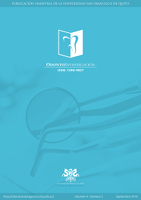Social determinants and prevalence of dental caries in the school population in rural and urban areas of Ecuador
Main Article Content
Abstract
Dental caries is a consequence of multiple causal factors and constitutes a local and global public health problem. Objective: to explore the association between social determinants and prevalence of dental caries in school-age population of rural and urban areas in Ecuador. Materials and Methods: Cross sectional study developed by a dental team trained under the World Health Organization criteria applied an oral clinical examination of 518 children aged 3 to 15 years and also complemented data collection with a socio-demographic survey for information regarding hygienic and dietary habits, access to health services and social conditions of children. Results: Caries in definitive teeth is statistically associated to: caries in primary teeth p<.000, absence of toothbrush in school p<.003, lack of access to an oral health unit p<.006, and poor self-perception of oral health p<.012, and. Caries in primary teeth is significantly associated to: male sex p<.001, poor self-perception of oral health p <.013, last visit to the dentist in more than six months p<.040, and absence of toothbrush in school<.050. Conclusion: Among the participating school age children of this study, dental caries is a consequence of multiple causal factors.
Article Details
How to Cite
Ortega Pérez, F., Guerrero, A., & Aliaga, P. (2018). Social determinants and prevalence of dental caries in the school population in rural and urban areas of Ecuador. OdontoInvestigación, 4(2). https://doi.org/10.18272/oi.v4i2.1281

